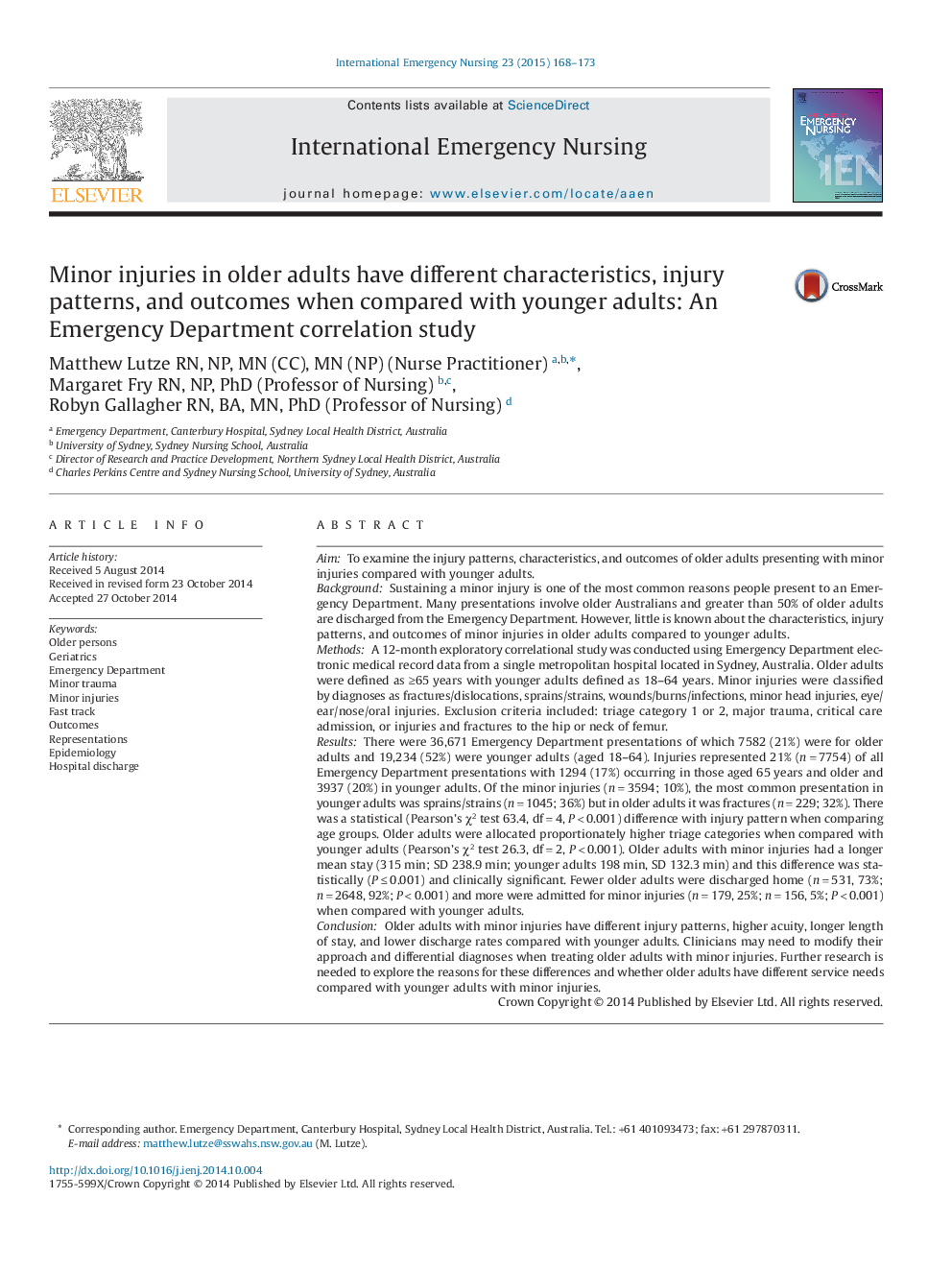| کد مقاله | کد نشریه | سال انتشار | مقاله انگلیسی | نسخه تمام متن |
|---|---|---|---|---|
| 2609363 | 1134543 | 2015 | 6 صفحه PDF | دانلود رایگان |
• Approximately 10% of ED presentations are for minor injuries.
• One in five minor injuries (20%) are in older adults (age ≥65 years).
• Older adults with minor injuries are less likely to be discharged home compared to younger adults (73% v. 92%).
• Fractures and dislocations are more common in older persons than sprains and strains.
• Older adults with minor injuries have nearly twice the length of stay of younger adults (315 min v. 198 min).
AimTo examine the injury patterns, characteristics, and outcomes of older adults presenting with minor injuries compared with younger adults.BackgroundSustaining a minor injury is one of the most common reasons people present to an Emergency Department. Many presentations involve older Australians and greater than 50% of older adults are discharged from the Emergency Department. However, little is known about the characteristics, injury patterns, and outcomes of minor injuries in older adults compared to younger adults.MethodsA 12-month exploratory correlational study was conducted using Emergency Department electronic medical record data from a single metropolitan hospital located in Sydney, Australia. Older adults were defined as ≥65 years with younger adults defined as 18–64 years. Minor injuries were classified by diagnoses as fractures/dislocations, sprains/strains, wounds/burns/infections, minor head injuries, eye/ear/nose/oral injuries. Exclusion criteria included: triage category 1 or 2, major trauma, critical care admission, or injuries and fractures to the hip or neck of femur.ResultsThere were 36,671 Emergency Department presentations of which 7582 (21%) were for older adults and 19,234 (52%) were younger adults (aged 18–64). Injuries represented 21% (n = 7754) of all Emergency Department presentations with 1294 (17%) occurring in those aged 65 years and older and 3937 (20%) in younger adults. Of the minor injuries (n = 3594; 10%), the most common presentation in younger adults was sprains/strains (n = 1045; 36%) but in older adults it was fractures (n = 229; 32%). There was a statistical (Pearson's χ2 test 63.4, df = 4, P < 0.001) difference with injury pattern when comparing age groups. Older adults were allocated proportionately higher triage categories when compared with younger adults (Pearson's χ2 test 26.3, df = 2, P < 0.001). Older adults with minor injuries had a longer mean stay (315 min; SD 238.9 min; younger adults 198 min, SD 132.3 min) and this difference was statistically (P ≤ 0.001) and clinically significant. Fewer older adults were discharged home (n = 531, 73%; n = 2648, 92%; P < 0.001) and more were admitted for minor injuries (n = 179, 25%; n = 156, 5%; P < 0.001) when compared with younger adults.ConclusionOlder adults with minor injuries have different injury patterns, higher acuity, longer length of stay, and lower discharge rates compared with younger adults. Clinicians may need to modify their approach and differential diagnoses when treating older adults with minor injuries. Further research is needed to explore the reasons for these differences and whether older adults have different service needs compared with younger adults with minor injuries.
Journal: International Emergency Nursing - Volume 23, Issue 2, April 2015, Pages 168–173
